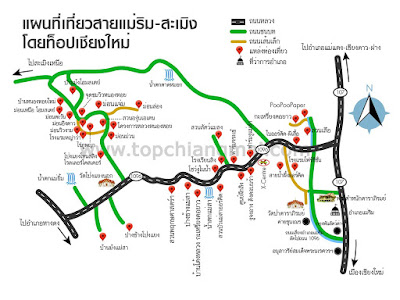Janine Yasovant : MPA.
A string musical instrument called "Phin Pia" used to be popular in the northern royal court in ancient time. Later, it was spread to the villagers who were quite rich and capable of playing musical instruments. It can be said that the headstock of Phin Pia on the top of the string instrument was an important component which was rare and very expensive. Phin Pia is a hard instrument to learn but its sound is very pleasant. Anyone who could play it
would be praised specially. This made young Lanna men sought this instrument to practice because it would be beneficial for them during the visit to impress young maidens in the village in the night. This was the popular custom after working in the rice field in the day.
Phin Pia is one of the most ancient Lanna musical instruments. It is evolved from Phin Thanu (Another type of string instrument). There are 2 -7 strings. The sound box is made from the coconut shell. The handle is made of hardwood grinded into cylindrical shape. One sharp end of the handle connects with the headstock.
เครื่องดนตรีที่เรียกว่า พิณเปี๊ยะเคยนิยมอย่างแพร่หลายกันแต่ในราชสำนักฝ่ายเหนือสมัยโบราณ ต่อมาได้แพร่ออกมาสู่กลุ่มชาวบ้านที่พอมีฐานะ และมี ฝีมือทางดนตรี กล่าวกันว่า เพราะส่วนหัวพิณเปี๊ยะซึ่งอยู่ด้านบนของเครื่องดนตรี สาย ที่เป็นส่วนประกอบสำคัญนั้นหายากและมีราคาแพง ประกอบกับ พิณเปี๊ยะเป็นเครื่องดนตรีที่เล่นยากและมีเสียงไพเราะมาก ดังนั้นใครที่เล่นเปี๊ยะได้ก็จะเป็นที่ยกย่องชื่มชมเป็นพิเศษ ทำให้หนุ่มๆ ล้านนาสมัยก่อนนิยมที่จะเสาะแสวงหาเปี๊ยะมาเล่นกัน เพราะจะได้เปรียบเครื่องดนตรีชนิดอื่นในเวลาที่ไปเยี่ยมเยือนสาวงามในหมู่บ้าน ยามค่ำคืน ซึ่งถือเป็นธรรมเนียมปฎิบัติ หลังจากทำงานในท้องไร่ท้องนาเวลากลางวัน
Phin Pia is one of the most ancient Lanna musical instruments. It is evolved from Phin Thanu (Another type of string instrument). There are 2 -7 strings. The sound box is made from the coconut shell. The handle is made of hardwood grinded into cylindrical shape. One sharp end of the handle connects with the headstock.
พินเปี๊ยะ เครื่องดนตรีโบราณล้านนาที่มีความเก่าแก่มากที่สุดชิ้นหนึ่งมีวิวัฒนาการมาจากพิณธนู มีสายตั้งแต่ 2-7 สาย กล่องเสียงทำด้วยกะลามะพร้าว ด้ามทำด้วยไม้เนื้อแข็งเหลาเป็นทรงกระบอกปลายด้านหนึ่งเรียวแหลมสวมไว้กับหัวเปี๊ยะ
In Lanna Language, Pia means to show off. A young man from the village who had musical skill would travel to the young maiden's house to play this instrument to her family in the night. There were light from the lamps in the village that night. They called it "The visit to maiden's house" to find the marriage partner.
ในภาษาล้านนาคำว่า “เปี๊ยะ” หมายถึง อวด หรือ แสดง ชายหนุ่มจากหมู่บ้าน เอาความสามารถทางเล่นดนตรี ไปโชว์ให้ครอบครัวหญิงสาวดูยามค่ำคืน ที่มีการจุดตะเกียง สว่างไสว และเรียกการไปเยือนบ้าน อวดเพื่อนๆ ว่า ไปแอ่วสาว ..เพื่อจะเลือกคู่ครอง
The music was the part of the dance for men and women who had to practice hard. Everything was in the observation of the family and their friends. To win her heart and accepted by her family, the man had to play the instrument well. Also, the maiden dressed and danced well in this occasion.
ดนตรีจะเป็นส่วนหนึ่งของการร่ายรำ ทั้งชายหญิง และต้องมีการฝึกซ้อมอย่างดี เพราะทุกอย่างจะอยู่ในสายตาและการยอมรับของครอบครัวและเหล่า เพื่อนๆ การที่จะชนะใจของทุกคนที่ชายต้องมาเยือนบ้านของหญิงสาว การเล่นดนตรีได้ ก็เป็นสิ่งที่โดดเด่นชนะใจ ฝ่ายสาว..เจ้าก็จะมีการแต่งกายงดงาม ร้องรำทำเพลงได้ในเวลาเหมาะสม ...เช่นกัน
It is said that the man who played this instrument might not wear his shirt because the the sound box made of coconut shell must be placed on his chest. Doing this, the sound would be more pleasant.
มีกล่าวกันว่าฝ่ายชายเมื่อเล่นดนตรี อาจจะไม่สวม เสื้อ หรือต้องปลดกระดุมเสื้อ เพราะเป็นเครื่องดนตรีที่จะต้องเล่นแนบกับอก ด้านส่วนของกะลา เสียงดนตรีที่เกิดขึ้นจะไพเราะมาก
Phin Pia was the only musical instrument for men and it was not wrong to show off tattoos on his chest and back or two arms. Pia is to show the beauty of his body to others. Compare to the present, men with good muscles or six packs are desirable by many in the world.
พิณเปี๊ยะจึงเป็นเครื่องดนตรีของ ฝ่ายชายเท่านั้น และไม่ผิด กติกาอันใด คงจะเป็นการ การอวดลายสัก ที่มีตรงหน้าอกและหลัง หรือต้นเเขนทั้ง2 ข้าง หรือต้องการเปี๊ยะ คือโชว์ความงามของตนให้ ผู้อื่นได้ชม ซึ่งเป็น คล้ายๆกับ ซิกแพค ส่วนบนที่นิยมว่า สวยงาม ในรูปร่างที่ดี ที่เป็นที่พึงปรารถนาทั่งโลก
Made in 2018 at Pamsilapa, Jai Yong Art House.
สร้างปีพุทธศักราช ๒๕๖๑ — at ผามศิลปะ เฮินศิลป์ใจ๋ยอง.
“เพลงพิณที่พระพุทธองค์ทรงสดับ”
พิณเปี๊ยะ ๔ สายไม้พญางิ้วดำ....สล่าเคี่ยน อักษร มาเอี้ยง
หัวพิณเปี๊ยะ.... ผลงานอาจารย์ ธงชัย ศรีสุขประเสริฐ
กะโหล้งจารลายคำ “ปัญจสิงขรเทวบุตรคนธรรพ์ บรรเลงเพลงพิณถวายแด่พระสัมมาสัมพุทธเจ้า”..... ลิปิกร มาแก้ว
สร้างปีพุทธศักราช ๒๕๖๑ — at ผามศิลปะ เฮินศิลป์ใจ๋ยอง.
"The song heard by the Buddha"
4 strings Phin Pia made of Ebony Wood
Salah Kian Akson Ma-iang
Headstock of Phin Pia ... Made by
Thongchai Srisukprasert
The picture of
Kaho Langjarn Laikham
"Panjasingkhon the angel and his group play the Phin music for the Buddha"
... By Lipikorn Makaew
Made in 2018 at Pamsilapa, Jai Yong Art House.



































